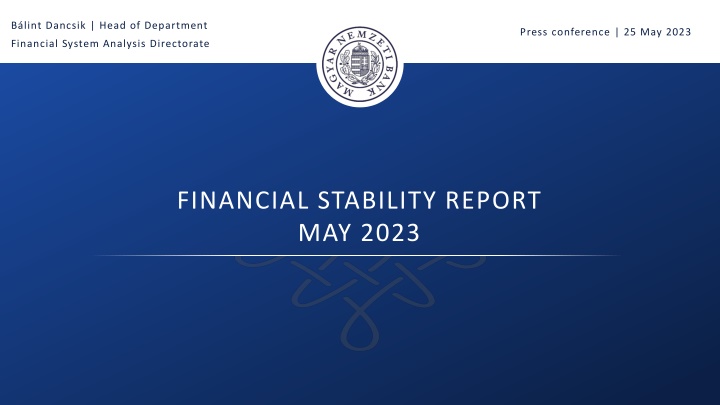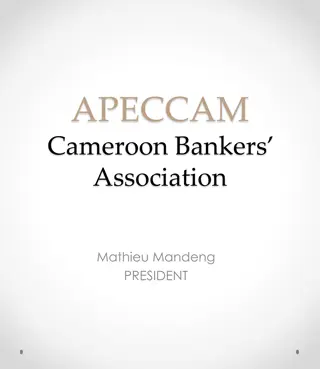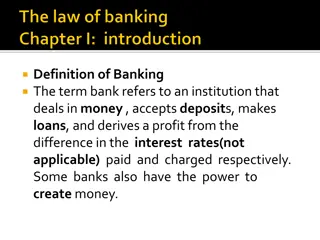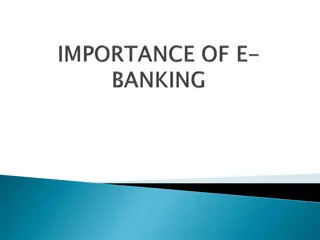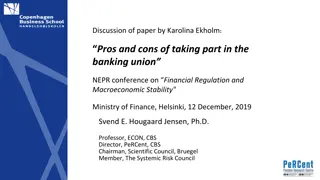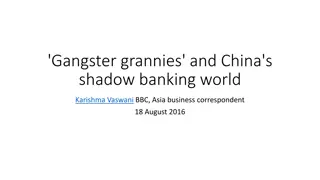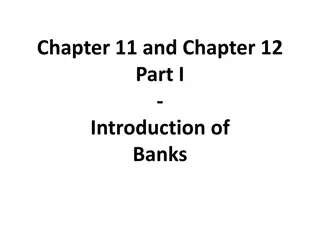Hungarian Banking System Stability Report May 2023
The Financial Stability Report for May 2023 of the Hungarian banking system highlights the resilience of banks despite international failures. The report discusses indicators of financial stability, risks faced by banks, and the sector's robust capital position. There are insights on private sector loans, real estate market trends, credit conditions, and bank profitability. External risks from the international environment remain elevated, with challenges such as slow global economic growth and geopolitical risks. Overall, the report emphasizes the strong position of the Hungarian banking system in navigating complex financial landscapes.
Download Presentation

Please find below an Image/Link to download the presentation.
The content on the website is provided AS IS for your information and personal use only. It may not be sold, licensed, or shared on other websites without obtaining consent from the author.If you encounter any issues during the download, it is possible that the publisher has removed the file from their server.
You are allowed to download the files provided on this website for personal or commercial use, subject to the condition that they are used lawfully. All files are the property of their respective owners.
The content on the website is provided AS IS for your information and personal use only. It may not be sold, licensed, or shared on other websites without obtaining consent from the author.
E N D
Presentation Transcript
Blint Dancsik | Head of Department Press conference | 25 May 2023 Financial System Analysis Directorate FINANCIAL STABILITY REPORT MAY 2023
BANKS' SHOCK RESILIENCE REMAINS STABLE, PREVIOUS RISKS HAVE NOT MATERIALISED The international bank failures have had a temporary negative impact on the valuations of European and Hungarian banks, but the fundamentals of the banking systems, with strict regulation and supervision, make them resilient to similar events. QUESTIONS sajto@mnb.hu Financial Stability Indicators Liquid assets / total assets Loand-to-deposit ratio External liabilities / total liabilities Capital adequacy ratio of the banking system (consolidated data in brackets) 2008 10.0% 152% 33.9% 11.2% (12.9%) 4.6% 16.0% 11.3% 2.4% 66.3% 2019 30.9% 75% 12.7% 22.5% (18.0%) 2.1% 2.1% 11.6% 2.0% 0.7% 2022 40.5% 71% 10.3% 19.5% (18.2%) 1.3% 1.9% 8.9% 1.6% 0.5% Most severe risks: Risk tolerance reduction Possible additional sanctions, war exposures of parent banks Potential decrease in deposits Slowing credit dynamics Tighter credit conditions Real estate market risks, overvaluation Share of loans with 90+ days delinquency Net NPL / regulatory capital Return on equity Operating costs / total assets Share of FX loans in the household loan portfolio Share of variable rate loans in the household loan portfolio Annual growth rate of corporate lending Annual growth rate of household lending 77.5% 48.7% 18.4% 6.5% 19.0% 14.2% 16.7% 13.8% 6.3% Financial stability indicators of the Hungarian banking system Source: MNB | 2
MAIN TAKEAWAYS OF THE REPORT The Hungarian banking system has a stable, strong capital position and significant liquidity reserves in the complex and challenging period. The sector's ability to withstand shocks is strong, and its liquidity and capital position are robust even assuming a severe crisis. QUESTIONS sajto@mnb.hu Loans of the private sector increased in 2022, but at the same time, similar to regional trends, a general decline in demand can be felt. There are signs of a turnaround in the real estate market, which is gradually reflected in the valuation as well. The average price of houses decreased nominally in the second half of 2022, and several segments of CRE are surrounded by increasing risks. The tightening of credit conditions is mainly due to cyclical factors, the lending capacities of banks are adequate. The increasing impairments, the settlement of the extra profit tax, and the profit impact of the interest cap measures were almost completely compensated by the increase in the net interest income. | 3
External environment QUESTIONS sajto@mnb.hu Corporate and household lending Bank profitability and portfolio quality Bank shock resilience | 4
RISKS STEMMING FROM THE INTERNATIONAL ENVIRONMENT REMAINED ELEVATED IN THE LAST HALF-YEAR ECB per cent per cent 5.5 5.5 Slow global economic growth, elevated inflationary environment, tight monetary conditions, persistent geopolitical risks. 5.0 5.0 4.5 4.5 QUESTIONS sajto@mnb.hu 4.0 4.0 3.5 3.5 3.0 3.0 2.5 2.5 Dynamically changing expected interest rate paths at major central banks. 2.0 2.0 1.5 1.5 1.0 1.0 0.5 0.5 0.0 Energy supply problems in Europe have proved milder than expected. 0.0 Mar-23 Jun-24 Aug-23 Jan-24 Nov-24 Mar-23 Aug-23 Jan-24 Jun-24 Nov-24 31-10-2022 17-02-2023 29-03-2023 28-04-2023 EXPECTED INTEREST RATE PATHS OF THE CENTRAL BANKS OF DEVELOPED COUNTRIES BASED ON MARKET PRICING Note |Expected interest rate paths are based on interest rate swaps in the case of the Fed and EONIA forward yields in the case of the ECB. Source | Bloomberg | 5
BANK INTEREST AND LIQUIDITY RISK MANAGEMENT AND ITS REGULATION CAME INTO FOCUS FOLLOWING THE AMERICAN BANK FAILURES Concentrated clients, high proportion of deposits not covered by deposit insurance, interest rate risk Sale of held-to- maturity securities at a loss Outflow of deposits QUESTIONS sajto@mnb.hu Low quality risk management, weak regulatory control Negative news, social media catalyst effect Deterioration of capital position MAIN FACTORS LEADING TO THE FAILURE OF SILICON VALLEY BANK | 6 Source |MNB. The topic is covered in Box 1 of the report.
BANK FAILURES HAVE REASSESSED THE IMPACT OF THE RISING INTEREST RATE ENVIRONMENT ON THE BANKING SYSTEM per cent per cent 120 120 When monetary tightening was started, the general view was that rising interest rates would be benign for banks. 110 110 100 100 QUESTIONS sajto@mnb.hu 90 90 80 80 Stress indices rose in March, but the elevated levels were below those recorded during the coronavirus outbreak and the energy crisis. 70 70 60 60 May-22 Jul-22 Mar-22 Oct-22 Mar-23 Apr-22 Jun-22 Apr-23 Dec-22 Jan-22 Jan-23 Aug-22 Nov-22 Feb-22 Sep-22 Feb-23 After the initial fall in share prices following the SVB's bankruptcy, a correction was observed. EUR STOXX S&P500 EUR STOXX Banks Dow Jones US Banks CHANGES IN THE VALUATION OF EUROPEAN AND US BANKS COMPARED TO THE DEVELOPMENT OF MAJOR STOCK INDICES | 7 Note | 03-01-2022=100%. Source | Yahoo Finance, Marketwatch
THE IMF ESTIMATES THAT BANKS' POTENTIAL LOSSES ON SECURITIES COULD BE MUCH HIGHER IN THE US THAN IN EUROPE AND EMERGING MARKETS basis points basis points 50 50 The European and thedomestic banking regulation is much stricter than overseas, therefore it can prevent the occurrence of bank failures similar to the case of Silicon Valley Bank. 0 0 QUESTIONS sajto@mnb.hu -50 -50 -100 -100 -150 -150 The liquidity coverage ratio (LCR) requirement applies to all banks. -200 -200 Domestic regulations require additional liquidity to be maintained after large deposits. -250 -250 -300 -300 -350 -350 ~700 basis points The MNB monitors the level of interest rate risk for all banks and, if necessary, imposes extra capital requirements on institutions (Pillar II). -400 -400 5th percentile Median 95th percentile USA Europe Japan Emerging markets ESTIMATED IMPACT ON CET1 RATIO FROM UNREALIZED GAINS AND LOSSES ON HELD-TO- MATURITY SECURITIES | 8 Source | IMF Global Financial Stability Report
EU BANKING SYSTEM IS STABLE, AND SHOWS IMPROVING PROFITABILITY percentage points 5.0 5.5 6.0 6.5 7.0 7.5 8.0 8.5 ROE - 2021 Q4 7.3 QUESTIONS sajto@mnb.hu Profitability in the EU banking system improved as net interest income increased Other expenses (incl. tax) -0.8 Impairments (credit risk losses) -0.3 Other operating income -0.3 -0.1 Contributions to funds* Admin. expenses (incl. depreciation) In several countries, the above- average income has been or is planned to be deducted with special taxes. -0.1 Net fee & commission income -0.1 0.1 Staff expenses Net trading income (incl. FV result) 0.3 (HU, CZ, ES, [LT, IT]) Provisions 0.4 This is discussed in Box 2 of the report. Net interest income 1.8 ROE - 2022 Q3 8.0 5.0 5.5 6.0 6.5 7.0 7.5 8.0 8.5 percentage points CONTRIBUTION OF CHANGES IN CERTAIN PROFITABILITY COMPONENTS TO THE ANNUAL CHANGE IN AVERAGE ROE IN THE EU BANKING SYSTEM | 9 Note | *Contributions to deposit guarantee schemes and resolution funds. Source | EBA
External environment QUESTIONS sajto@mnb.hu Corporate and household lending Bank profitability and portfolio quality Bank shock resilience | 10
CORPORATE LOANS OUTSTANDING NOMINALLY INCREASED BY 14 PER CENT IN 2022, PARTLY AS A RESULT OF LARGE INDIVIDUAL TRANSACTIONS Until the end of 2023, several state loan programmes will help the SME and corporate sector with discounted funds. per cent per cent 20 20 18 18 16 16 QUESTIONS sajto@mnb.hu 14 14 The subsidized programmes can partly cover the renewal needs of SME loans. Among the outstanding bank loans of SMEs at the end of 2022, loans maturing in 2023 have an outstanding principal amount of around HUF 1,120 billion. 12 12 10 10 8 8 6 6 4 4 7.1 per cent (2023Q4) 2 2 0 0 -2 -2 -4 -4 -6 -6 -8 -8 The stock of corporate liquid assets in Hungary has grown significantly in recent years: the value of liquid assets as a share of GDP reached 20 per cent in 2013, in line with the regional average, and exceeded 32 per cent by the end of 2021. -10 -10 2008 2009 2010 2011 2012 2013 2014 2015 2016 2017 2018 2019 2020 2021 2022 2023 2024 2025 2026 Corporate annual growth rate Forecast FORECAST FOR THE CORPORATE LOAN PORTFOLIO Note | Transaction-based annual growth rate based on data from the financial intermediary system. Source | MNB | 11
COMPARED TO 2021, CORPORATE LOAN DEMAND HAS SHIFTED TOWARDS FOREIGN CURRENCY AND SHORT-TERM LOANS HUF bn HUF bn As a result of declining corporate investment activity and mounting liquidity needs, banks perceived a decrease in demand for long-term loans and an increase in demand for working capital loans 1 400 1 400 Thousands Thousands 1 200 1 200 QUESTIONS sajto@mnb.hu 1 000 1 000 800 800 600 600 The demand for foreign currency loans also increased. At the same time, such loans were mostly taken out by companies with natural collateral in recent months. 400 400 200 200 0 0 Oct Oct Oct Oct Oct Jan-18 Apr July Jan-19 Apr July Jan-20 Apr July Jan-21 Apr July Jan-22 Apr July No foreign trade activities and real estate activities No foreign trade activities and not real estate activities Net exporter Net importer, has export income Net importer, has no export income CUMULATIVE FOREIGN CURRENCY LOAN CONTRACTS WITHIN A YEAR BY FOREIGN TRADE ACTIVITY OF THE CORPORATE BORROWERS | 12 Note | Exchange rate adjusted values. Source | NTCA, MNB
THE LENDING CAPACITY OF THE BANKING SYSTEM IS HISTORICALLY HIGH, AND ITS WILLINGNESS TO LEND IS AROUND THE EQUILIBRIUM LEVEL per cent per cent Russian- Ukrainian war 100 100 Global economic crisis In the last two quarters, a small group of banks tightened their corporate loan terms. In the first quarter, only a net 9 percent of banks indicated their capital situation and liquidity situation as factors influencing the tightening of credit conditions. Coronavirus pandemic TIGHTENING 80 80 EU sovereign debt crisis 60 60 QUESTIONS sajto@mnb.hu 40 40 20 20 0 0 Meanwhile, almost two-thirds of them indicated the economic outlook. EASING -20 -20 -40 -40 According to our financial conditions index, the impact of the banking system on the real economy is overall neutral: neither cools nor heats the economy. Q2 Q4 Q2 Q3 Q4 Q2 Q3 Q4 Q2 Q3 Q4 Q3 Q4 Q2 Q3 Q2 Q3 Q4 2008 H1 2008 H2 2011 Q1 2009 Q1 2010 Q1 2020 Q1 2021 Q1 2022 Q1 2023 Q1 2023 Q2-Q3 (e.) Capital position Liquidity position Economic outlook Changes in credit conditions (RHS) CHANGES IN CREDIT CONDITIONS AND FACTORS CONTRIBUTING TO THE CHANGES IN THE CORPORATE SEGMENT Note | Net ratio is the difference between tightening and easing banks weighted by market share. The indicated ratios are the net ratio of the institutions indicating the given factor, so the sum of the parts is not 100 per cent. Source | MNB based on banks' responses | 13
MARKET SLOWDOWN IS CLEARLY VISIBLE IN HOUSEHOLD LENDING per cent per cent 30 30 New disbursement: 25 25 20 20 The volume of new household lending fell by 10 per cent in 2022. QUESTIONS sajto@mnb.hu 15 15 10 10 In the first quarter of 2023, new housing loan disbursement decreased by 67 per cent y-o-y. 5 5 0 0 -5 -5 2,4% (2023Q2) Loans outstanding: -10 -10 -15 -15 The slowdown in lending dynamics continued at the beginning of 2023, with the annual growth rate of households bank loans outstanding at only 5.1 per cent in the first quarter. -20 -20 2008 Q1 2009 Q1 2010 Q1 2011 Q1 2012 Q1 2013 Q1 2014 Q1 2015 Q1 2016 Q1 2017 Q1 2018 Q1 2019 Q1 2020 Q1 2021 Q1 2022 Q1 2023 Q1 2024 Q1 2025 Q1 2026 Q1 Forecast Household annual growth rate HOUSEHOLD LENDING FORECAST Note | Transaction-based annual growth rate based on data from the financial intermediary system. Source | MNB | 14
THE DECELERATION OF CREDIT MARKET IS A WIDESPREAD PHENOMENON IN THE WHOLE REGION per cent per cent 200 200 Uncertain growth prospects and tightening of monetary conditions set back housing loan demand in the whole region. 175 175 150 150 125 125 QUESTIONS sajto@mnb.hu 100 100 75 75 50 50 A general slowdown in credit markets is apparent, which is a natural phenomenon, an adjustment to the changing economic outlook both at the demand side and at the supply side. 25 25 0 0 -25 -25 -50 -50 -75 -75 Q2 Q2 Q2 Q3 Q3 Q3 Q4 Q2 Q3 Q4 Q3 Q4 Q2 Q3 Q4 Q4 Q2 Q3 Q4 Q2 Q4 2016 Q1 2017 Q1 2018 Q1 2019 Q1 2020 Q1 2021 Q1 2022 Q1 Czechia Hungary Poland See more on the topic in Box no. 4 of the Report. Romania Slovakia Euro area ANNUAL CHANGE IN NEW HOUSING LOAN CONTRACTS IN AN INTERNATIONAL COMPARISON | 15 Source | MNB, ECB.
BANKS PERCEIVED DECREASING DEMAND FOR HOUSING LOANS AND STRONGER DEMAND FOR CONSUMER LOANS Housing loan conditions Net 11 per cent of banks tightened the consumer loan conditions, 32 per cent plan to tighten them further Banks did not change credit conditions and do not plan to change them looking forward QUESTIONS sajto@mnb.hu 0 % 2023 Q1 0 % 2023 Q2-Q3 Housing loan demand Net 76 per cent of banks perceived the drop in demand, but 27 per cent envisage the appreciation of it looking ahead 2023 Q1 -76 % Net 42 per cent of banks saw an upturn in demand for consumer loans 2023 Q2-Q3 +27 % Note: Net percentage balance of respondent banks indicating stronger/weaker demand and tightened/eased credit conditions, weighted by market share. Source: MNB, based on banks responses. | 16
External environment QUESTIONS sajto@mnb.hu Corporate and household lending Bank profitability and portfolio quality Bank shock resilience | 17
THE SURGE IN INTEREST INCOME ALSO COVERED SEVERAL EXTRA EXPENSES -600 -400 -200 0 200 400 600 HUF bn Level in 2022 Q4: Net interest income of the banking system increased by HUF 675 billion in 2022 compared to 2021. 510 Income - 2021 Q4 Impairment -285 -438 QUESTIONS sajto@mnb.hu -323 Bank levy* -264 2 Net trading income -149 Its main source is interest income on deposits with the MNB. Operating costs -114 -1093 Other -74 -388 -25 -18 Other provisioning While the average interest rate on HUF demand and time deposits held by households and corporates in banks has increased by only 3.6 percentage points since June 2021. 837 Interest income - Other -104 898 Interest income - MNB 779 231 Dividends 93 113 784 Fee and commission inc. Income - 2022 Q4 485 -600 -400 -200 0 200 400 600 HUF bn ANNUAL CHANGES IN THE AFTER-TAX INCOME COMPONENTS OF THE CREDIT INSTITUTION SECTOR Note | Nominal values of income components at the end of 2022 are shown on the right-hand side. Interest income - MNB does not include interest income on derivative transactions with the MNB. *Bank levy includes the combined change in the normal bank levy and the extra profit tax. Source | MNB | 18
THE REPRICING OF RETAIL TERM DEPOSITS LAGS SIGNIFICANTLY BEHIND THE INCREASE IN SHORT-TERM INTERBANK YIELDS and also from the expected level based on the previous relationship between interbank and deposit interest rates, which topic we deal with - statistical methods - in the highlighted chapter of the report. per cent per cent Why is the transmission different? Possible reasons: abundant liquidity, competition (difficulties switching bank accounts), residential government bonds, financial awareness, government measures(interest stop, windfall tax) 18 18 QUESTIONS sajto@mnb.hu 16 16 14 14 12 12 10 10 8 8 6 6 4 4 In the medium term, the low level of interest increases the risk of a decrease in the deposit stock, but at the same time there is still considerable room for maneuver due to the high liquidity reserves at the system level. 2 2 0 0 2004 2009 Interest rate - Household sight deposits Interest rate - Household term deposits 3 month BUBOR Interest rate - Corporate sight deposits Interest rate - Corporate term deposits 2023 2003 2005 2006 2007 2008 2010 2011 2012 2013 2014 2015 2016 2017 2018 2019 2020 2021 2022 THE AVERAGE ANNUALIZED INTEREST RATE OF THE HUF DEPOSITS OF THE PRIVATE SECTOR AND THE DEVELOPMENT OF THE AVERAGE MONTHLY LEVEL OF THE 3-MONTH BUBOR | 19 Source | MNB
BANKING SECTOR'S RETURN ON EQUITY DID NOT CHANGE SIGNIFICANTLY COMPARED TO THE PREVIOUS YEAR per cent per cent 100 25 90 20 80 15 70 10 QUESTIONS sajto@mnb.hu RoE (2022): 9% 60 5 50 0 The profitability of banks was well below the cost of equity for nearly one third of the sector on a balance sheet total basis. 40 -5 30 -10 20 -15 10 -20 0 -25 2007 2008 2009 2010 2011 2012 2014 2015 2016 2017 2018 2019 2021 2022 2023 2013 2020 ROE: below -20% ROE: -10% 0% ROE: 10% 20% Sector-wide ROE (RHS) ROE: -20% -10% ROE: 0% 10% ROE: above 20% Yield premium (RHS) DISTRIBUTION OF 12-MONTH ROLLING AFTER-TAX RETURN ON EQUITY OF CREDIT INSTITUTIONS WEIGHTED BY THE BALANCE SHEET TOTAL Note | Monthly time series based on non-consolidated data. The yield premium is the difference between the 12-month rolling ROE and the yield on the one-year Discount Treasury Bill. Backward-looking yield for the ROE, forward-looking yield for the Discount Treasury Bill. Source | MNB | 20
CREDIT RISKS HAVE NOT YET MATERIALISED, WHICH IS SUPPORTED BY THE STABLE LABOUR MARKET HUF Bn % Dec. 2021 Dec. 2022 Feb. 2023 3 000 25.0 2 700 22.5 Corporate NPL 2 400 20.0 4.1% 3.9% 3.7% QUESTIONS sajto@mnb.hu 2 100 17.5 Household NPL 1 800 15.0 4.2% 4.4% 4.3% 1 500 12.5 Corporate 90+ days delinquency 1 200 10.0 0.7% 1.2% 1.2% 900 7.5 600 5.0 Household 90+ days delinquency 300 2.5 1.3% 1.5% 1.5% 0 0.0 Q3 Q3 Q3 Q3 Q3 Q3 Q3 Q3 Q3 Q3 Q3 Q3 Q3 Q3 Q3 Q3 2007Q1 2008Q1 2009Q1 2010Q1 Nonperforming loans not more than 90 days past due Loans with 90+ days delinquency 31-90 days delinquency ratio (RHS) 90+ days delinquency ratio (RHS) Nonperforming loan ratio (RHS) 2011Q1 2012Q1 2013Q1 2014Q1 2015Q1 2016Q1 2017Q1 2018Q1 2019Q1 2020Q1 2021Q1 2022Q1 Corporate delinquency below 90 days 3.5% 5.2% 3.4% Household delinquency below 90 days 4.1% 4.5% 4.5% NON-PERFORMING LOAN VOLUME AND NPL-RATIO OF THE PRIVATE SECTOR TOWARDS THE CREDIT INSTITUTION SECTOR | 21 Source | MNB
HOUSEHOLD INTEREST RATE CAP MEASURE HAS A LIMITED DEBT-SERVICE EFFECT ON THE MACRO LEVEL, IT SHOULD BE TARGETED TOWARDS THE MOST AFFECTED per cent per cent 14 14 The effect can be significant on the micro-level: 12 12 10 10 Median instalment would have increased by one and a half time (from 41 thousand HUF to 63 thousand HUF), had the interest rate cap been phased out at the end of June 2023. This would have resulted in financial stress for certain households (especially in the case of longer remaining maturities). QUESTIONS sajto@mnb.hu 8 8 6 6 4 4 2 2 0 0 2019 2021 2023 2005 2006 2007 2008 2009 2010 2011 2012 2013 2014 2015 2016 2017 2018 2020 2022 Additional interest service ratio without interest rate cap Interest service ratio Loan principal service ratio Interest rate on mortgage loans outstanding with interest rate cap Interest rate on mortgage loans outstanding without interest rate cap DEBT-SERVICE OF THE HOUSEHOLDS AS A RATIO OF THEIR SECTORAL DISPOSABLE INCOME AND INTEREST RATE ON MORTGAGE LOANS OUTSTANDING WITH AND WITHOUT THE INTEREST RATE CAP Note | Calculated with an interest forward path as of 19 April. Interest repayment burdens and principal repayments are calculated as a proportion of the disposable income of the household segment. The excess repayment burden without the interest rate cap was calculated ceteris paribus, i.e. only the interest rate on mortgages was changed compared to the scenario with the interest rate cap, everything else was assumed unchanged. The interest rate time series on the outstanding mortgage loan portfolio is a volume- weighted average interest rate, which is calculated from 2020 Q1 onwards on the basis of micro-data from the Credit Registry. Source | MNB | 22
INCREASE IN CREDIT RISKS: SIGNS OF A HOUSING MARKET TURNAROUND ARE VISIBLE IN MANY EU COUNTRIES 80 The housing loan market and housing market decline may point in the direction of a turnaround that can be linked to economic uncertainty, a high inflation environment, tight monetary conditions and (in some countries) housing market overvaluation. IE Annual change in newly disbursed housing loans, 60 QUESTIONS sajto@mnb.hu 40 MT 2022 Q4 (per cent) 20 BG DK LV ES EE 0 There is no close correlation between the increase in loan interest rates and the degree of contraction of the credit market in EU countries. Based on the latest data, there was a 40-70 percent drop in housing loan disbursements in many EU countries, where the increase in average loan interest rates was "only" 150-250 basis points. LT IT PT FI RO LU AT BE -20 SE SI EU CY FR NL DE -40 SK HU -60 CZ HR PL -80 -8 -6 -4 -2 0 2 4 6 8 Quarterly change in housing prices, 2022 Q4 (per cent) QUARTERLY CHANGE IN HOUSING PRICES AND THE ANNUAL CHANGE IN THE DISBURSEMENT OF NEW HOUSING LOANS IN THE EU Source | ECB, Eurostat, MNB | 23
STABILITY EFFECTS OF THE CORRECTION IN HOUSING MARKET OVERVALUATION ARE LIMITED per cent per cent 16 16 14 14 15.4 per cent of the portfolio 12 12 QUESTIONS sajto@mnb.hu 10 10 We estimate that, with a full correction of housing market overvaluation, 15.4 per cent of the mortgage stock would be above 80 per cent LTV, which does not represent a significant risk. 8 8 6 6 4 4 2 2 0 0 The topic is presented in Box 5 of the report. 70-80% 90-100% 10-20% 20-30% 30-40% 40-50% 50-60% 60-70% 80-90% 10% or below over 100% Loan-to-value ratio Current LTV LTV adjusted for overvaluation DISTRIBUTION OF THE MORTGAGE LOAN PORTFOLIO ACCORDING TO THE CURRENT AND ADJUSTED LTV FOR HOUSING MARKET OVERVALUATION Note | December 2022 stock. The overvaluation was calculated based on the percentage deviation of the house price-to income-ratio from its long-term average. Housing prices of 2022 are calculated based on the first three quarter. Source | MNB | 24
BANKS CONSERVATIVE COLLATERAL VALUATION PRACTICE ALSO CONTRIBUTED TO THE MODERATE RISKS per cent per cent 350 350 Financial institutions gradually increased the value of residential real estate collaterals behind the mortgage loans on their balance sheets considering the housing market price increase. At the same time, the revaluation of collateral was carried out conservatively. 300 300 250 250 QUESTIONS sajto@mnb.hu 200 200 150 150 100 100 50 50 0 0 -50 -50 2008 Q2 2009 Q2 2010 Q2 2011 Q2 2012 Q2 Quarter of conclusion of contract 2014 Q2 2015 Q2 2016 Q2 2017 Q2 2018 Q2 2019 Q2 2020 Q2 2022 Q2 Q4 Q4 Q4 Q4 Q4 Q4 Q4 Q4 Q4 Q4 Q4 Q4 Q4 Q4 Q4 2013 Q2 2021 Q2 Revaluation of mortgage collateral since the conclusion of contract - 25-75th. percentile Revaluation of mortgage collateral since the conclusion of contract - 10-90th percentile Revaluation of mortgage collateral since conclusion of contract - median Increase in housing prices nationwide since the conclusion of contract Increase in housing prices in Budapest since the conclusion of contract REVALUATION OF MORTGAGE COLLATERAL AND THE RATE OF INCREASE IN HOUSE PRICES BETWEEN THE DATE OF CONCLUSION OF THE CONTRACT AND 2022 Q4 | 25 Note | Based on the outstanding mortgage loan portfolio at the end of December 2022. The housing price increase is based on the MNB housing price index. Source | MNB
BANK EXPOSURE RELATED TO COMMERCIAL REAL ESTATE IS MODERATE per cent per cent 100 10 Risks in the office market: 90 9 80 8 Valuation: based on the development of prime office yield and rent, Budapest's prime offices may have depreciated by 14 per cent, which is higher than the regional average, but significantly less than the level and dynamics of the change after 2008. QUESTIONS sajto@mnb.hu 70 7 60 6 50 5 40 4 30 3 20 2 Hidden vacancy : due the prevalence of remote work, there are many workstations that are not actually used, which can mean cost reduction potential for tenants and an upward risk in the vacancy rate. 10 1 0 0 2010 2018 2008 2009 2011 2012 2013 2014 2015 2016 2017 2019 2020 2021 2022 CRE project loan stock / own funds CRE project loan stock / sector balance sheet total (RHS) CRE project loan stock / GDP (RHS) THE SIGNIFCANCE OF COMMERCIAL REAL ESTATE PROJECT LOANS IN THE BANKING SYSTEM Note | Credit institutions excluding affiliates, based on non-consolidated data, increased by the real estate Bond Funding for Growth Scheme (BGS) portfolio. Source | MNB | 26
External environment QUESTIONS sajto@mnb.hu Corporate and household lending Bank profitability and portfolio quality Bank shock resilience | 27
THE LIQUIDITY POSITION OF THE BANKING SYSTEM REMAINS ROBUST HUF bn per cent 16 000 240 The liquidity surplus at the sector level provides sufficient coverage even for a severe stress scenario. 14 000 210 12 000 180 10 000 150 QUESTIONS sajto@mnb.hu 8 000 120 6 000 90 4 000 60 Banks have an operational liquidity reserve (OLR) of around HUF 16,000-18,000 billion supplemented with. mandatory reserves, which is currently around 60 percent of the deposit portfolio 2 000 30 0 0 -2 000 -30 -4 000 -60 -6 000 -90 -8 000 -120 -10 000 -150 -12 000 -180 -14 000 -210 -16 000 -240 -18 000 -270 Mar-20 Mar-21 Mar-22 Mar-23 Jul-20 Jul-21 Jul-22 May-20 May-21 May-22 Nov-20 Jan-21 Nov-21 Jan-22 Nov-22 Jan-23 Sep-20 Sep-21 Sep-22 During our liquidity stress test, the level of liquidity deficit occurring at the sector level remains close to the theoretical minimum. Inflows Liquid assets Sector level LCR (RHS) Outflows Net outflows DEVELOPMENT OF THE LCR AND ITS COMPONENTS IN THE BANKING SYSTEM The topic is dealt with in Box 3 of the report | 28 Source | MNB
IN OUR STRESS TEST, SUBSTANTIAL CREDIT RISK LOSSES CAN BE REALIZED IN THE VULNERABLE EXTERNAL ENVIRONMENT The narrative of the stress test is primarily determined by the uncertainties of the international environment. per cent per cent QUESTIONS sajto@mnb.hu 8 8 STRESSTEST ASSUMPTIONS: The protracted Russian-Ukrainian war and the European energy crisis, as well as the potential spillover from the international financial markets, continue to surround the operating environment of the domestic banking sector with substantive downward growth risks. In the stress scenario, GDP growth falls behind the first and second years of the baseline forecast by a cumulative 6 percent and 10 percent, respectively. 6 6 4 4 2 2 0 0 -2 -2 -4 -4 -6 -6 -8 -8 2012 2021 2008 2009 2010 2011 2013 2014 2015 2016 2017 2018 2019 2020 2022 2023 2024 2025 Midpoint of the baseline forecast range Stress scenario ANNUAL GDP GROWTH RATE IN THE SCENARIOS | 29 Source | MNB
BANKS WOULD MAINTAIN THEIR LENDING CAPACITY EVEN IN THE EVENT OF A SEVERE STRESS The sector-level capital adequacy ratio was 18 percent at the end of 2022. QUESTIONS sajto@mnb.hu Overall, at the end of the first and second year of the stress scenario, there is no capital shortage in the case of any institution, but the level of free capital buffers decreases significantly even with the diminishing asset portfolio. On the one hand, the smaller credit dynamics of the dynamic balance sheet assumption and the resulting lower total risk exposure value play a role in this, but at the same time, banks would maintain their lending capacity even in the event of severe stress. DISTRIBUTION OF THE CAPITAL ADEQUACY RATIO BASED ON THE NUMBER OF BANKS | 30 Note | Vertical line: 10 90 per cent range; rectangle: 25 75 per cent range. The banking sector average is weighted by the total risk exposure. Source | MNB
MAIN TAKEAWAYS OF THE REPORT The Hungarian banking system has a stable, strong capital position and significant liquidity reserves in the complex and challenging period. The sector's ability to withstand shocks is strong, and its liquidity and capital position are robust even assuming a severe crisis. QUESTIONS sajto@mnb.hu Loans of the private sector increased in 2022, but at the same time, similar to regional trends, a general decline in demand can be felt. There are signs of a turnaround in the real estate market, which is gradually reflected in the valuation as well. The average price of houses decreased nominally in the second half of 2022, and several segments of CRE are surrounded by increasing risks. The tightening of credit conditions is mainly due to cyclical factors, the lending capacities of banks are adequate. The increasing impairments, the settlement of the extra profit tax, and the profit impact of the interest cap measures were almost completely compensated by the increase in the net interest income. | 31
THANK YOU FOR YOUR ATTENTION! 32 |
